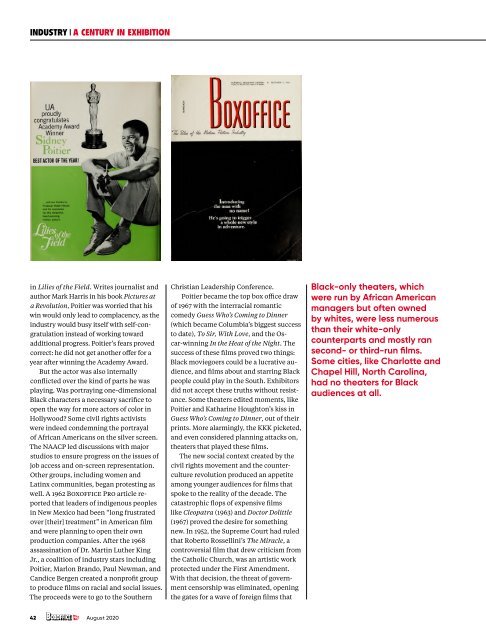Boxoffice Pro - August 2020
The Official Magazine of the National Association of Theatre Owners
The Official Magazine of the National Association of Theatre Owners
- No tags were found...
You also want an ePaper? Increase the reach of your titles
YUMPU automatically turns print PDFs into web optimized ePapers that Google loves.
INDUSTRY A CENTURY IN EXHIBITION<br />
in Lilies of the Field. Writes journalist and<br />
author Mark Harris in his book Pictures at<br />
a Revolution, Poitier was worried that his<br />
win would only lead to complacency, as the<br />
industry would busy itself with self-congratulation<br />
instead of working toward<br />
additional progress. Poitier’s fears proved<br />
correct: he did not get another offer for a<br />
year after winning the Academy Award.<br />
But the actor was also internally<br />
conflicted over the kind of parts he was<br />
playing. Was portraying one-dimensional<br />
Black characters a necessary sacrifice to<br />
open the way for more actors of color in<br />
Hollywood? Some civil rights activists<br />
were indeed condemning the portrayal<br />
of African Americans on the silver screen.<br />
The NAACP led discussions with major<br />
studios to ensure progress on the issues of<br />
job access and on-screen representation.<br />
Other groups, including women and<br />
Latinx communities, began protesting as<br />
well. A 1962 <strong>Boxoffice</strong> <strong>Pro</strong> article reported<br />
that leaders of indigenous peoples<br />
in New Mexico had been “long frustrated<br />
over [their] treatment” in American film<br />
and were planning to open their own<br />
production companies. After the 1968<br />
assassination of Dr. Martin Luther King<br />
Jr., a coalition of industry stars including<br />
Poitier, Marlon Brando, Paul Newman, and<br />
Candice Bergen created a nonprofit group<br />
to produce films on racial and social issues.<br />
The proceeds were to go to the Southern<br />
Christian Leadership Conference.<br />
Poitier became the top box office draw<br />
of 1967 with the interracial romantic<br />
comedy Guess Who’s Coming to Dinner<br />
(which became Columbia’s biggest success<br />
to date), To Sir, With Love, and the Oscar-winning<br />
In the Heat of the Night. The<br />
success of these films proved two things:<br />
Black moviegoers could be a lucrative audience,<br />
and films about and starring Black<br />
people could play in the South. Exhibitors<br />
did not accept these truths without resistance.<br />
Some theaters edited moments, like<br />
Poitier and Katharine Houghton’s kiss in<br />
Guess Who’s Coming to Dinner, out of their<br />
prints. More alarmingly, the KKK picketed,<br />
and even considered planning attacks on,<br />
theaters that played these films.<br />
The new social context created by the<br />
civil rights movement and the counterculture<br />
revolution produced an appetite<br />
among younger audiences for films that<br />
spoke to the reality of the decade. The<br />
catastrophic flops of expensive films<br />
like Cleopatra (1963) and Doctor Dolittle<br />
(1967) proved the desire for something<br />
new. In 1952, the Supreme Court had ruled<br />
that Roberto Rossellini’s The Miracle, a<br />
controversial film that drew criticism from<br />
the Catholic Church, was an artistic work<br />
protected under the First Amendment.<br />
With that decision, the threat of government<br />
censorship was eliminated, opening<br />
the gates for a wave of foreign films that<br />
Black-only theaters, which<br />
were run by African American<br />
managers but often owned<br />
by whites, were less numerous<br />
than their white-only<br />
counterparts and mostly ran<br />
second- or third-run films.<br />
Some cities, like Charlotte and<br />
Chapel Hill, North Carolina,<br />
had no theaters for Black<br />
audiences at all.<br />
42 <strong>August</strong> <strong>2020</strong>

















